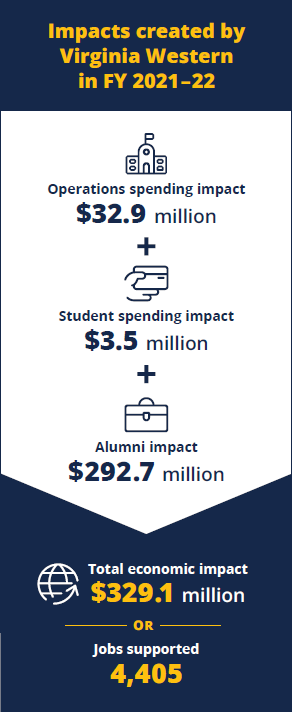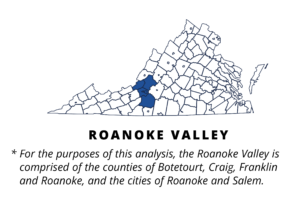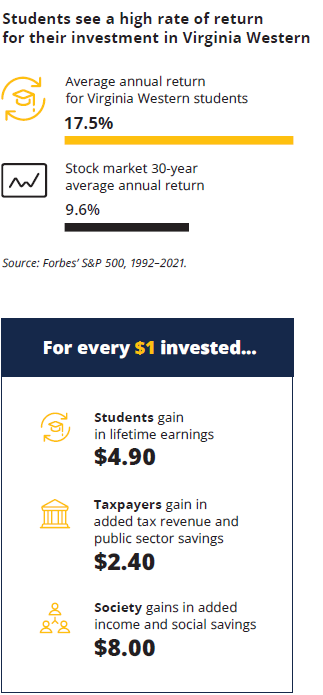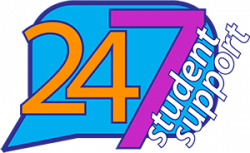
Virginia Western Community College creates a significant positive impact on the business community and generates a return on investment to its major stakeholder groups — students, taxpayers and society. Using a two-pronged approach that involves an economic impact analysis and an investment analysis, this study calculates the benefits received by each of these groups. Results of the analysis reflect fiscal year (FY) 2021-22.
Economic impact analysis

In FY 2021-22, Virginia Western added $329.1 million in income to the Roanoke Valley* economy, a value approximately equal to 1.7% of the region’s total gross regional product (GRP). Expressed in terms of jobs, Virginia Western’s impact supported 4,405 jobs. For perspective, the activities of Virginia Western and its students support one out of every 46 jobs in the Roanoke Valley.
Operations spending impact
- Virginia Western employed 509 full-time and part-time faculty and staff. Payroll amounted to $23.2 million, much of which was spent in the region for groceries, mortgage and rent payments, dining out and other household expenses. The college spent another $27.1 million on day-to-day expenses related to facilities, supplies and professional services.
- The net impact of the college’s operations spending added $32.9 million in income to the regional economy in FY 2021-22.
Student spending impact
- Around 15% of students attending Virginia Western originated from outside the region. Some of these students relocated to the Roanoke Valley. In addition, some in-region students, referred to as retained students, would have left the Roanoke Valley for other educational opportunities if not for Virginia Western. These retained students spent money on groceries, mortgage and rent payments, and other living expenses at regional businesses.
- The expenditures of relocated and retained students in FY 2021-22 added $3.5 million in income to the Roanoke Valley economy.
Alumni impact
- Over the years, students have studied at Virginia Western and entered or re-entered the workforce with newly acquired knowledge and skills. Today, thousands of these former students are employed in the Roanoke Valley.
- The net impact of Virginia Western’s former students currently employed in the regional workforce amounted to $292.7 million in added income in FY 2021-22.
Investment analysis
Student perspective

- Virginia Western’s FY 2021-22 students paid a present value of $19.4 million to cover the cost of tuition, fees, supplies, and interest on student loans. They also forwent $16.7 million in time and in money that they would have earned had they been working instead of attending college.
- In return for their investment, students will receive a cumulative present value of $176.5 million in increased earnings over their working lives. This translates to a return of $4.90 in higher future earnings for every dollar students invest in their education. Students’ average annual rate of return is 17.5%.
Taxpayer perspective
- Taxpayers provided Virginia Western with $21.6 million of funding in FY 2021-22. In return, they will benefit from added tax revenue, stemming from students’ higher lifetime earnings and increased business output, amounting to $48.5 million. A reduced demand for government-funded services in Virginia will add another $4.1 million in benefits to taxpayers.
- Total taxpayer benefits amount to $52.6 million, the present value sum of the added tax revenue and public sector savings. For every dollar of public money invested in Virginia Western, taxpayers will receive $2.40 in return, over the course of students’ working lives. The average annual rate of return for taxpayers is 5.8%.
Social perspective
- In FY 2021-22, Virginia invested $72.2 million to support Virginia Western. This includes the college’s expenditures, student expenses and student opportunity costs. In turn, the Virginia economy will grow by $562.3 million, over the course of students’ working lives. Society will also benefit from $12.2 million in public and private sector savings.
- For every dollar invested in Virginia Western in FY 2021-22, people in Virginia will receive $8.00 in return, for as long as Virginia Western’s FY 2021-22 students remain active in the Virginia workforce.
About the study
Data and assumptions used in the study are based on several sources, including the FY 2021-22 academic and financial reports from Virginia Western Community College, Virginia Community College System (VCCS), industry and employment data from the U.S. Bureau of Labor Statistics and U.S. Census Bureau, outputs of Lightcast’s Multi-Regional Social Accounting Matrix model, and a variety of studies and surveys relating education to social behavior. The study applies a conservative methodology and follows standard practice using only the most recognized indicators of economic impact and investment effectiveness. For a full description of the data and approach used in the study, please contact the college for a copy of the main report.
About Lightcast
Lightcast is renowned for its national reach and impeccable reputation in the realm of higher education. Leveraging cutting-edge data analytics, Lightcast partners with educational institutions across the United States to enhance decision-making, streamline program development, and align curricula with market needs. Their expertise in labor market insights and economic data empowers universities and colleges to stay ahead of trends, ensuring that students are equipped with skills that meet the evolving demands of the workforce. This commitment to bridging the gap between education and employment cements Lightcast as a pivotal player in the higher education sector.

